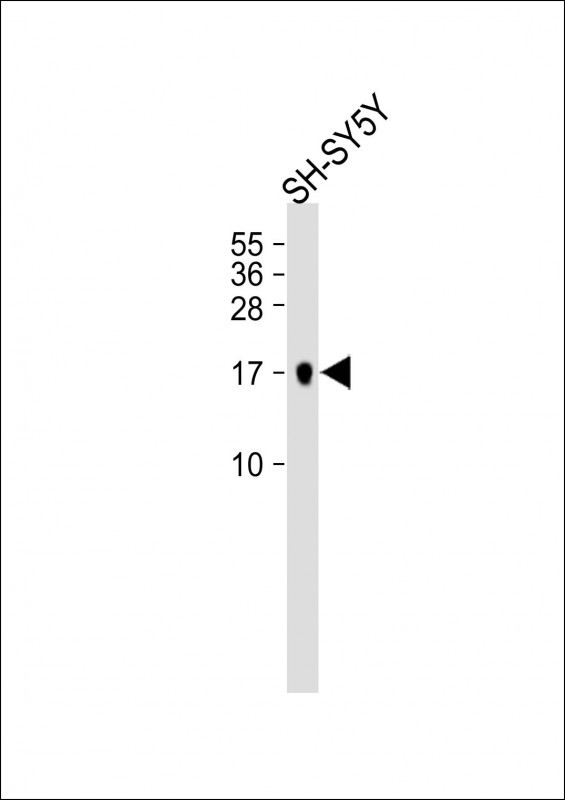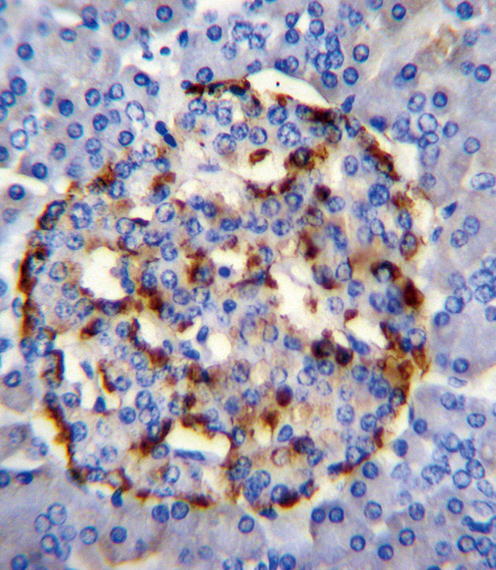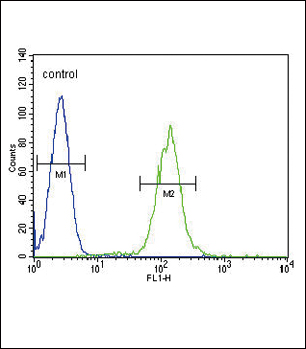PLA2G2D Antibody (C-term)
Affinity Purified Rabbit Polyclonal Antibody (Pab)
- 产品详情
- 实验流程
- 背景知识
Application
| WB, IHC-P, FC, E |
|---|---|
| Primary Accession | Q9UNK4 |
| Other Accession | NP_036532.1 |
| Reactivity | Human |
| Host | Rabbit |
| Clonality | Polyclonal |
| Isotype | Rabbit IgG |
| Calculated MW | 16546 Da |
| Antigen Region | 105-131 aa |
| Gene ID | 26279 |
|---|---|
| Other Names | Group IID secretory phospholipase A2, GIID sPLA2, sPLA2-IID, PLA2IID, Phosphatidylcholine 2-acylhydrolase 2D, Secretory-type PLA, stroma-associated homolog, PLA2G2D, SPLASH |
| Target/Specificity | This PLA2G2D antibody is generated from rabbits immunized with a KLH conjugated synthetic peptide between 105-131 amino acids from the C-terminal region of human PLA2G2D. |
| Dilution | WB~~1:2000 IHC-P~~1:100~500 FC~~1:10~50 E~~Use at an assay dependent concentration. |
| Format | Purified polyclonal antibody supplied in PBS with 0.05% (V/V) Proclin 300. This antibody is purified through a protein A column, followed by peptide affinity purification. |
| Storage | Maintain refrigerated at 2-8°C for up to 2 weeks. For long term storage store at -20°C in small aliquots to prevent freeze-thaw cycles. |
| Precautions | PLA2G2D Antibody (C-term) is for research use only and not for use in diagnostic or therapeutic procedures. |
| Name | PLA2G2D |
|---|---|
| Synonyms | SPLASH |
| Function | Secretory calcium-dependent phospholipase A2 that primarily targets extracellular lipids, exerting anti-inflammatory and immunosuppressive functions (PubMed:10455175, PubMed:10681567). Hydrolyzes the ester bond of the fatty acyl group attached at sn-2 position of phospholipids (phospholipase A2 activity) with preference for phosphatidylethanolamines and phosphatidylglycerols over phosphatidylcholines (PubMed:10455175). In draining lymph nodes, selectively hydrolyzes diacyl and alkenyl forms of phosphatidylethanolamines, releasing omega-3 polyunsaturated fatty acids (PUFAs) such as eicosapentaenoate and docosahexaenoate that are precursors of the anti-inflammatory lipid mediators, resolvins (By similarity). During the resolution phase of acute inflammation drives docosahexaenoate-derived resolvin D1 synthesis, which suppresses dendritic cell activation and T-helper 1 immune response (By similarity). May act in an autocrine and paracrine manner (By similarity). Via a mechanism independent of its catalytic activity, promotes differentiation of regulatory T cells (Tregs) and participates in the maintenance of immune tolerance (By similarity). May contribute to lipid remodeling of cellular membranes and generation of lipid mediators involved in pathogen clearance. Displays bactericidal activity against Gram-positive bacteria by directly hydrolyzing phospholipids of the bacterial membrane (By similarity). |
| Cellular Location | Secreted. |
| Tissue Location | Highly expressed in pancreas and spleen and less abundantly in colon, thymus, placenta, small intestine, and prostate |
For Research Use Only. Not For Use In Diagnostic Procedures.
Provided below are standard protocols that you may find useful for product applications.
BACKGROUND
Transposase-derived protein that may have nuclease activity (Potential). Does not have transposase activity.
REFERENCES
Davila, S., et al. Genes Immun. 11(3):232-238(2010)
Segat, L., et al. Vaccine 28(10):2201-2206(2010)
Igarashi, A., et al. Respiration 78(3):312-321(2009)
Lessig, J., et al. Asian J. Androl. 10(6):829-836(2008)
Lindbom, J., et al. Inflammation 29 (2-3), 108-117 (2005) :
终于等到您。ABCEPTA(百远生物)抗体产品。
点击下方“我要评价 ”按钮提交您的反馈信息,您的反馈和评价是我们最宝贵的财富之一,
我们将在1-3个工作日内处理您的反馈信息。
如有疑问,联系:0512-88856768 tech-china@abcepta.com.























 癌症的基本特征包括细胞增殖、血管生成、迁移、凋亡逃避机制和细胞永生等。找到癌症发生过程中这些通路的关键标记物和对应的抗体用于检测至关重要。
癌症的基本特征包括细胞增殖、血管生成、迁移、凋亡逃避机制和细胞永生等。找到癌症发生过程中这些通路的关键标记物和对应的抗体用于检测至关重要。 为您推荐一个泛素化位点预测神器——泛素化分析工具,可以为您的蛋白的泛素化位点作出预测和评分。
为您推荐一个泛素化位点预测神器——泛素化分析工具,可以为您的蛋白的泛素化位点作出预测和评分。 细胞自噬受体图形绘图工具为你的蛋白的细胞受体结合位点作出预测和评分,识别结合到自噬通路中的蛋白是非常重要的,便于让我们理解自噬在正常生理、病理过程中的作用,如发育、细胞分化、神经退化性疾病、压力条件下、感染和癌症。
细胞自噬受体图形绘图工具为你的蛋白的细胞受体结合位点作出预测和评分,识别结合到自噬通路中的蛋白是非常重要的,便于让我们理解自噬在正常生理、病理过程中的作用,如发育、细胞分化、神经退化性疾病、压力条件下、感染和癌症。








